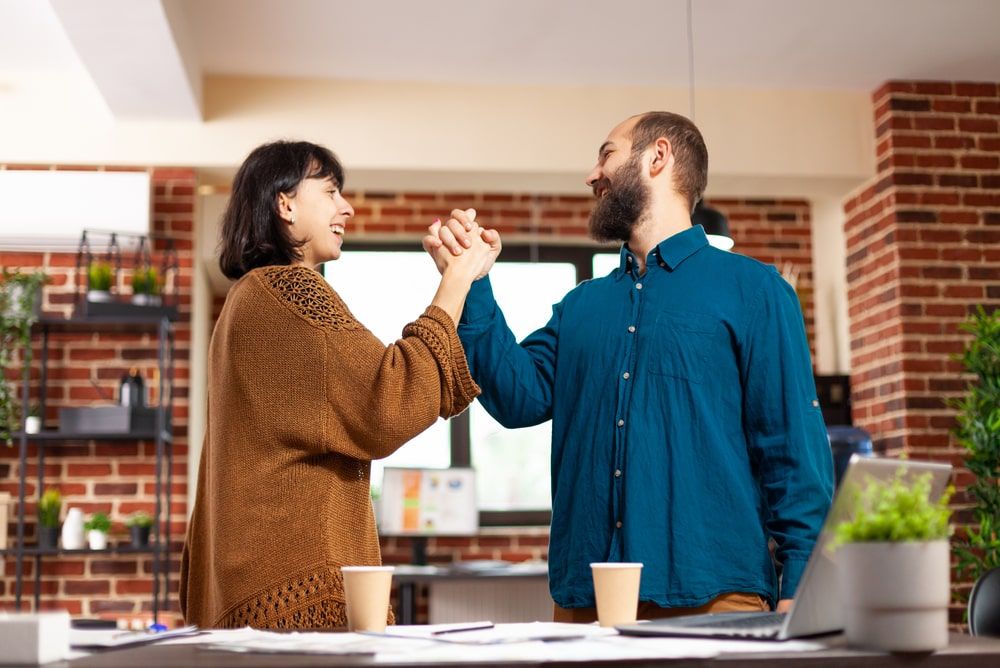
Are you struggling to find ways to motivate your team and boost their productivity? Look no further! In this blog post, we will explore effective strategies and techniques that will help you inspire and engage your team members. Whether you're a team leader, manager, or entrepreneur, understanding how to motivate your team is crucial for achieving your goals and driving success.
Employee recognition plays a pivotal role in boosting motivation and morale within a team. By acknowledging and appreciating the hard work and dedication of your team members, you create a positive work environment that fosters productivity and loyalty. In addition to employee recognition, we will also delve into other powerful methods, such as setting clear goals, providing constructive feedback, fostering open communication, and offering growth opportunities. So, if you're ready to unlock the full potential of your team and take your leadership skills to the next level, keep reading to discover the secrets of how to motivate your team.
Foundational Principles of Motivation

Motivation is the fuel that drives individuals and teams to achieve greatness. It is the invisible force that propels us forward, even in the face of adversity. Motivation is not just a nice-to-have quality; it is absolutely crucial in a team setting. In this section, we will explore the foundational principles of motivation and why they are essential for a high-performing team.
1. Purpose: Fueling the Fire Within
The purpose is the heartbeat of motivation. It is the why behind what we do. When team members have a clear understanding of their purpose and how their work contributes to the bigger picture, they are more likely to feel motivated. As a leader, it is your responsibility to communicate the purpose to your team and help them see the impact of their contributions.
2. Recognition: Celebrating Success
Recognition is the secret ingredient that makes motivation flourish. When team members receive acknowledgment for their hard work and achievements, it boosts their confidence and drives them to continue performing at their best. Take the time to recognize and celebrate both individual and team accomplishments. Show your appreciation and let them know that their efforts are valued.
A unique and engaging way to do this could involve surprising your team with a HelloFresh subscription – a popular meal prep kits delivery service. Based in Germany, HelloFresh found significant success in the United States and it delivers weekly selected meals right to your door. With dozens of menu options to choose from, it could be a thoughtful, practical token of gratitude.
3. Autonomy: Empowering the Individual
Autonomy is the freedom to make decisions and take ownership of one's work. When team members are given the power to make choices and have control over their tasks, it enhances their motivation. Empower your team by delegating responsibilities and trusting them to deliver. Encourage creativity and innovation, and provide support when needed. Autonomy breeds motivation.
4. Growth: Fuel for Ambition
Growth is the lifeblood of motivation. As human beings, we have an innate desire to learn, develop, and progress. Provide opportunities for your team members to expand their skills and knowledge. Offer training, mentorship, and challenging projects that stretch their capabilities. When individuals see the potential for personal and professional growth, they are motivated to push themselves to new heights.
5. Communication: The Glue that Binds
Communication is the foundation of a motivated team. Open and transparent communication fosters trust, collaboration, and accountability. Regularly check in with your team members to understand their goals, challenges, and aspirations. Listen actively and provide constructive feedback. Communicate the vision, goals, and expectations clearly to ensure everyone is aligned and motivated to work towards a common objective.
6. Positive Work Environment: Cultivating the Motivation Oasis
A positive work environment is like a garden where motivation can flourish. Create a culture of positivity, support, and respect. Encourage teamwork and collaboration. Foster a safe space where ideas can be freely shared and mistakes are seen as opportunities for growth. Provide a work environment that values and promotes well-being. When team members feel valued, supported, and happy, they are motivated to give their best.
Motivation is the secret sauce that transforms a group of individuals into a high-performing team. By understanding and applying the foundational principles of motivation - purpose, recognition, autonomy, growth, communication, and a positive work environment - you can unleash your team's full potential. Motivation is not a one-time event; it requires continuous nurturing and investment. So, fuel the fire within and watch your team soar to new heights!
Related Reading
• How To Improve Employee Morale • Benefits Of Employee Recognition • Why Is Employee Recognition Important • Employee Recognition Benefits • How To Improve Employee Satisfaction • Culture Of Recognition In The Workplace • Employee Recognition Statistics • Best Practices For Employee Recognition • Employee Anniversary Recognition
Why It's Important To Understand Team Dynamics

Motivating a team is no easy task. Every individual is unique, with different personalities, strengths, and motivators. Understanding these individual team dynamics also play a critical role in shaping the overall motivation and productivity of the group. Let's explore how understanding individual and team dynamics can help in tailoring motivational strategies that will truly inspire and drive your team toward success.
1. Uncovering Personal Motivators: Unlocking the Key to Individual Success
Every person has their own set of motivators that drive them to excel. By understanding and acknowledging these motivators, you can tap into what truly inspires each individual on your team. Some employees may be motivated by recognition and praise, while others may thrive on challenges or opportunities for growth. Taking the time to understand and identify these motivators will help you tailor your strategies to cater to the unique needs and desires of each team member.
For example, if you have a team member who values personal development, you can provide them with opportunities for training and growth. On the other hand, if someone is motivated by recognition, publicly acknowledging their achievements can be a powerful motivator. By recognizing these nuances and aligning your motivational strategies accordingly, you can create a more engaged and motivated team.
2. Leveraging Strengths: Empowering Individuals and the Team as a Whole
Understanding individual strengths is another crucial aspect of motivating your team. Each team member brings a unique set of skills and talents to the table, and leveraging these strengths can lead to increased motivation and productivity. When individuals are able to utilize their strengths and contribute meaningfully to the team, they feel a sense of empowerment and fulfillment.
By identifying and aligning tasks and responsibilities with each team member's strengths, you not only increase their motivation but also enhance the overall team dynamics. When everyone is playing to their strengths, it fosters a sense of collaboration and camaraderie within the team, leading to higher levels of motivation and productivity.
3. Nurturing Team Dynamics: Fostering Collaboration and a Sense of Belonging
Motivation is not solely dependent on individual factors. The dynamics within the team also play a significant role in shaping motivation levels. A positive and supportive team culture can go a long way in fueling motivation and fostering a sense of belonging. On the other hand, a toxic or dysfunctional team environment can quickly demoralize even the most motivated individuals.
By understanding the team dynamics, you can identify any potential issues or conflicts and take proactive steps to address them. Encouraging open communication, promoting teamwork, and providing opportunities for team-building activities can help strengthen the bonds between team members. When individuals feel supported and valued within the team, their motivation and commitment to the collective goals increase.
4. Flexibility and Adaptability: Tailoring Motivational Strategies as the Team Evolves
Teams are not static entities; they evolve over time. As individuals grow and change, so do their motivators and needs. Understanding these evolving dynamics is crucial in adapting and tailoring your motivational strategies accordingly. What may have motivated a team member in the past may not necessarily work for them now.
Regular check-ins, performance evaluations, and feedback sessions are essential in keeping a pulse on your team's motivation levels. By actively listening to their needs and responding to their feedback, you can refine and adjust your motivational strategies to ensure they remain relevant and effective.
Understanding individual and team dynamics is essential in tailoring motivational strategies that will truly inspire and drive your team toward success. By uncovering personal motivators, leveraging strengths, nurturing team dynamics, and remaining flexible and adaptable, you can create a motivated and high-performing team that is ready to take on any challenge. Motivation is not a one-size-fits-all approach. It requires a deep understanding of your team members as individuals and as a collective, and the willingness to adapt and evolve as their needs change.
Intrinsic and Extrinsic Motivators

When it comes to motivating your team, understanding the difference between intrinsic and extrinsic motivators is crucial. Intrinsic motivators are the internal factors that drive individuals to perform well, such as personal satisfaction, a sense of accomplishment, or a genuine passion for the work they do. On the other hand, extrinsic motivators are external rewards or incentives, such as promotions, bonuses, or recognition from superiors.
Intrinsic Motivators
Intrinsic motivators are like the fuel that ignites the fire within your team members. They tap into their individual passions and desires, making work more fulfilling and enjoyable. Here are some strategies to leverage intrinsic motivators and boost team morale and performance:
1. Foster a Sense of Purpose
Help your team members understand the bigger picture and how their work contributes to the overall goals of the organization. When individuals see the impact of their efforts, it ignites a sense of purpose and intrinsic motivation.
2. Encourage Mastery
Create opportunities for your team members to develop and improve their skills. By providing challenging assignments, training programs, or mentoring, you are giving them the chance to master their craft and feel a sense of personal growth and achievement.
3. Foster Autonomy
Empower your team members to make decisions and take ownership of their work. By giving them autonomy, you are signaling trust and respect, which can greatly enhance their intrinsic motivation. Encourage them to think creatively and take risks, knowing that their contributions are valued.
Extrinsic Motivators
Extrinsic motivators can be effective in boosting team morale and performance, especially when used in combination with intrinsic motivators. These external rewards provide recognition and tangible benefits that can inspire individuals to excel. Here's how you can leverage extrinsic motivators to motivate your team:
1. Recognize and Reward
Acknowledge the achievements and hard work of your team members. Whether it's a simple shout-out during a team meeting or a more formal recognition program, expressing appreciation and providing rewards can go a long way in boosting morale and motivation.
2. Provide Growth Opportunities
Offer opportunities for advancement, whether it's through promotions, career development programs, or additional responsibilities. This shows your team members that their efforts are recognized and rewarded, motivating them to strive for excellence.
3. Offer Incentives
Consider implementing a performance-based incentive program that rewards individuals for meeting or exceeding targets. Financial bonuses, gift cards, or other incentives can provide a tangible and motivating reward for a job well done.
By leveraging both intrinsic and extrinsic motivators, you can create a work environment that fuels passion, drive, and high performance. Motivation is not a one-size-fits-all approach, so take the time to understand what drives each team member and tailor your strategies accordingly. With the right mix of intrinsic and extrinsic motivators, you'll see your team thrive and exceed expectations.
The Role of Effective Leadership In Motivating A Team

When it comes to motivating a team, effective leadership is the key ingredient that can make or break success. A leader's influence can inspire team members to go above and beyond, pushing them to reach their full potential. But what exactly does effective leadership entail, and how does it impact motivation?
1. Visionary Leadership: Lighting the Path to Success
Effective leadership begins with a clear and compelling vision. A visionary leader paints a vivid picture of the team's goals and objectives, igniting a sense of purpose and direction. By communicating this vision, leaders inspire their team members to see the bigger picture and understand how their individual efforts contribute to the overall success. This sense of purpose fuels motivation and drives the team forward.
2. Leading by Example: Walking the Talk
Leadership isn't just about giving orders from the top; it's about leading by example. When leaders embody the values and behaviors they expect from their team members, it creates a powerful influence. Whether it's working hard, demonstrating resilience, or showing empathy, leading by example sets the standard for the team to follow. Seeing their leader actively embodying the desired qualities motivates team members to do the same, fostering a culture of excellence.
3. Empowering and Trusting Your Team: Unlocking Potential
Micromanagement stifles motivation, while empowerment and trust fuel it. Effective leaders empower their team members by delegating responsibilities, granting autonomy, and providing opportunities for growth. This shows trust in their abilities and allows individuals to take ownership of their work. When team members feel trusted and empowered, they are more likely to take initiative, think creatively, and go the extra mile to achieve success.
4. Effective Communication: Building Bridges and Fostering Collaboration
Communication is the lifeblood of any successful team. Effective leaders understand the importance of open, honest, and transparent communication. By keeping team members well-informed about goals, expectations, and progress, leaders eliminate confusion, align everyone's efforts, and create a sense of unity. Communication also involves active listening, allowing leaders to understand their team members' needs, concerns, and ideas. When team members feel heard and valued, it boosts morale and strengthens their motivation to contribute.
5. Recognition and Rewards: Celebrating Achievements
Recognition and rewards play a crucial role in motivating a team. Effective leaders understand the power of acknowledging and celebrating individual and team achievements. Whether it's a simple "thank you" or a more significant reward, the act of recognition validates team members' hard work and dedication. This recognition not only boosts morale but also reinforces desired behaviors and motivates individuals to continue performing at their best.
Effective leadership and communication are vital in motivating a team. By providing a clear vision, leading by example, empowering and trusting team members, fostering effective communication, and recognizing achievements, leaders can create an environment that inspires and motivates their team to reach new heights. As a leader, embrace these principles to unleash the full potential of your team and drive them towards collective success.
Motivational Theories To Get Inspiration From

Motivating a team is no easy task. It requires understanding the different factors that drive individuals and finding ways to align their motivations with the goals of the team. Luckily, there are several motivational theories that can help us understand what makes people tick and how to inspire them to reach their full potential. Let's explore two of these theories: Maslow's Hierarchy of Needs and Herzberg's Two-Factor Theory.
Maslow's Hierarchy of Needs
Maslow's theory suggests that individuals have a hierarchy of needs that must be met in a specific order. At the base of the pyramid are physiological needs such as food, water, and shelter. Once these needs are satisfied, individuals move up the pyramid to safety needs, then social needs, esteem needs, and finally self-actualization needs.
Addressing Team Members' Needs for Motivation
So, how does this theory apply to team motivation? Well, as a leader, it's important to understand the needs of your team members and provide support to help them meet those needs. For example, if someone is struggling with their basic physiological needs, such as not having enough money to cover their expenses, offering financial assistance or resources can be a powerful motivator. By addressing these foundational needs, you create a supportive environment that allows your team members to focus on their work and contribute to the team's success.
Herzberg's Two-Factor Theory
Herzberg's theory focuses on two factors that influence motivation: hygiene factors and motivators. Hygiene factors are elements in the work environment that, when absent, can cause dissatisfaction, but when present, do not necessarily lead to increased motivation. These factors include things like salary, job security, and work conditions.
On the other hand, motivators are the factors that directly contribute to job satisfaction and motivation. These include things like recognition, opportunities for growth and advancement, and a sense of achievement. According to Herzberg, providing these motivators can lead to higher job satisfaction and increased motivation among team members.
Addressing Team Members' Needs for Motivation
Applying this theory to team motivation means creating an environment where hygiene factors are taken care of, but also focusing on providing opportunities for growth and recognition. For example, offering training programs, mentoring opportunities, or acknowledging and celebrating achievements can greatly motivate your team. By tapping into these motivators, you create a positive work environment where team members feel valued and inspired to perform at their best.
Motivating your team is a continuous process that requires effort and understanding. By applying the principles of Maslow's Hierarchy of Needs and Herzberg's Two-Factor Theory, you can create a motivating environment that brings out the best in your team members. It's not just about the work itself, but also about understanding and meeting the needs and desires of your team members. So, unleash the power of motivation and watch your team soar to new heights!
35 Effective Ideas To Motivate Your Team
1. Cultivate a Positive Work Environment
Creating a positive work environment is essential to motivate your team. Foster a culture of collaboration, appreciation, and open communication.
2. Set Clear Goals
Clearly define the goals and objectives for your team. This will provide them with a sense of purpose and direction.
3. Offer Regular Feedback
Providing constructive feedback is crucial for growth and development. Regularly evaluate your team's performance and offer feedback that is specific, actionable, and encouraging.
4. Recognize Achievements
Celebrate the achievements of your team members. Whether it's a small win or a significant milestone, acknowledge their hard work and dedication.
5. Encourage Professional Development
Support your team members' professional growth by offering training opportunities, workshops, and resources. This shows that you are invested in their success and advancement.
6. Foster a Sense of Ownership
Empower your team by giving them ownership over their work. Encourage them to make decisions and take responsibility for the outcomes.
7. Provide Meaningful Rewards
Design a reward system that aligns with your team's values and motivates them to excel. This can include financial incentives, promotions, or extra time off.
8. Promote Work-Life Balance
Encourage your team to maintain a healthy work-life balance. Provide flexibility when possible and promote self-care practices.
9. Lead by Example
Be a role model for your team. Demonstrate the behavior and work ethic you expect from them.
10. Create Opportunities for Growth
Offer opportunities for your team members to take on new challenges and expand their skills. This keeps them engaged and motivated.
11. Foster a Supportive Team Culture
Encourage teamwork and collaboration. Create an environment where team members feel supported and can rely on one another.
12. Provide Autonomy
Trust your team members to make decisions and complete tasks independently. This fosters a sense of ownership and empowerment.
13. Celebrate Milestones
Recognize and celebrate milestones, both personal and professional, to show your team that their efforts are valued and appreciated.
14. Encourage Innovation
Foster an environment that values creativity and encourages new ideas. Encourage your team to think outside the box and reward innovative thinking.
15. Offer Skill Development Opportunities
Provide your team with opportunities to enhance their skills and knowledge through training programs, workshops, and conferences.
16. Communicate Clearly
Ensure that instructions, expectations, and feedback are communicated clearly and effectively. This avoids confusion and frustration.
17. Support Work-Life Integration
Recognize that work and personal life are interconnected. Offer flexibility and support to help your team balance their responsibilities.
18. Encourage Work-Life Integration
Recognize that work and personal life are interconnected. Offer flexibility and support to help your team balance their responsibilities.
19. Foster a Sense of Purpose
Connect your team's work to a larger purpose. Help them understand how their contributions make a difference.
20. Provide Opportunities for Advancement
Create a clear career progression path for your team members. Offer opportunities for growth and advancement within the organization.
21. Encourage Collaboration
Foster a sense of teamwork and collaboration. Encourage your team members to collaborate on projects and share ideas.
22. Set Realistic Deadlines
Avoid overwhelming your team with unrealistic deadlines. Set achievable goals and provide the necessary resources to meet them.
23. Offer Flexible Work Arrangements
Provide flexibility in work arrangements, such as remote work or flexible hours. This allows your team to have a better work-life balance.
24. Show Appreciation
Express gratitude and appreciation for your team's efforts. Recognize their hard work and acknowledge their contributions.
25. Promote a Healthy Work-Life Balance
Encourage your team to prioritize self-care and maintain a healthy work-life balance. Lead by example and encourage time off when needed.
26. Encourage Continuous Learning
Foster a culture of continuous learning. Encourage your team to seek out new knowledge and skills to stay motivated and grow professionally.
27. Delegate Responsibilities
Delegate tasks and responsibilities to your team members. This shows trust and allows them to develop their skills and take ownership of their work.
28. Emphasize Personal Growth
Support your team members' personal growth and development. Provide resources and opportunities for them to pursue their passions and interests.
29. Be Transparent
Be open and transparent with your team. Share information about company goals, challenges, and successes. This builds trust and fosters a sense of ownership.
30. Encourage Collaboration
Foster a sense of teamwork and collaboration. Encourage your team members to collaborate on projects and share ideas.
31. Provide a Supportive Work Environment
Create an environment where team members feel supported and valued. Offer mentorship, coaching, and resources to help them succeed.
32. Foster a Culture of Learning
Encourage your team to embrace a growth mindset and continuously seek out learning opportunities. Provide resources and support for their development.
33. Provide Work-Life Integration Support
Recognize that work and personal life are interconnected. Offer support and resources to help your team balance their responsibilities.
34. Create a Sense of Belonging
Foster a sense of belonging within your team. Create opportunities for team-building activities and encourage open communication and collaboration.
35. Promote Work-Life Balance
Encourage your team to maintain a healthy work-life balance. Provide flexibility when possible and promote self-care practices.
Motivating your team is all about creating an environment where individuals feel valued, supported, and empowered. By implementing these effective ideas, you can inspire and motivate your team to achieve greatness. Ready to unleash your team's full potential?
Related Reading
• Employee Recognition Awards • Employee Recognition Examples • Employee Rewards And Recognition • Employee Recognition Letter • Employee Recognition Day • Employee Rewards Examples • Employee Rewards And Recognition Program Examples • Creative Employee Recognition Ideas • Employee Recognition Programs Examples • Recognition Examples For Employees • Examples Of Employee Recognition Awards • Employee Recognition Program Names • Types Of Employee Recognition • Employee Recognition Survey Questions • Employee Recognition Criteria • Employee Recognition Gifts • Employee Recognition Wall Ideas • Employee Recognition Gifts for Years of Service • Employee Recognition Points System • Virtual Employee Recognition Ideas
Goal Setting To Create Clear Expectations To Drive Team Motivation

Setting clear expectations and driving team motivation are crucial aspects of effective team management. One way to achieve this is through goal setting and performance metrics. By implementing these strategies, leaders can provide their teams with a clear direction, establish measurable targets, and motivate team members to work towards achieving those goals. Let's dive into how goal setting and performance metrics can be used to create clear expectations and drive team motivation.
1. Establishing Clear Goals
Setting clear goals is the foundation of motivating a team. Clearly defined goals provide a sense of purpose and direction, ensuring that everyone understands what they need to accomplish. It's essential to make goals specific, measurable, achievable, relevant, and time-bound (SMART). This framework ensures that goals are realistic and attainable, which motivates team members to work towards them. When goals are clear and well-defined, team members can align their efforts and focus on what needs to be done.
2. Communicating Expectations
Once goals are established, it's crucial to effectively communicate expectations to the team. This involves providing clear instructions, discussing timelines, and outlining the desired outcomes. Leaders should ensure that team members understand their roles and responsibilities in achieving the goals. By communicating expectations clearly, leaders can eliminate any ambiguity and ensure that everyone is on the same page. This clarity motivates team members to take ownership of their tasks and work towards the common goal.
3. Tracking Performance
Performance metrics play a vital role in driving team motivation. By tracking individual and team performance, leaders can evaluate progress, identify areas for improvement, and provide feedback. Performance metrics provide tangible evidence of success and allow team members to see their progress toward the goals. When individuals can track their performance, they gain a sense of achievement and motivation to continue working toward success.
4. Providing Feedback and Recognition
Regular feedback and recognition are essential for team motivation. Leaders should provide constructive feedback to help team members enhance their performance and overcome any challenges. Recognizing and rewarding individual and team achievements is also crucial. By acknowledging their efforts and successes, team members feel valued and appreciated, which boosts morale and motivates them to excel further. Positive reinforcement creates a culture of motivation and encourages continuous improvement.
5. Encouraging Collaboration
Collaboration plays a significant role in driving team motivation. When team members work together towards a common goal, they can leverage each other's strengths, support one another, and achieve better results. Leaders should foster a collaborative environment by encouraging open communication, promoting teamwork, and facilitating opportunities for collaboration. By fostering collaboration, leaders can enhance team motivation and create a sense of camaraderie among team members.
Goal setting and performance metrics are powerful tools to create clear expectations and drive team motivation. By setting clear goals, communicating expectations, tracking performance, providing feedback and recognition, and encouraging collaboration, leaders can motivate their teams to achieve exceptional results. These strategies help team members understand their roles, align their efforts, and work towards common goals, fostering a motivated and high-performing team.
Strategies For Managers To Recognize Team Members for Their Contributions

Recognizing and rewarding team members for their contributions is a crucial aspect of motivating a team. When team members feel valued and appreciated, they are more likely to be motivated and engaged. Here are some effective strategies that managers can employ to recognize and reward team members for their contributions:
1. Public Recognition
Acknowledging and praising team members publicly can be a powerful motivator. Whether it's during team meetings, company-wide emails, or through social media platforms, giving public recognition not only boosts the morale of the individual being recognized but also sets a positive example for other team members. Celebrating milestones, achievements, and exceptional performance in front of the team helps foster a culture of appreciation and motivates others to strive for excellence.
2. Personalized Rewards
Tailoring rewards to individual team members' preferences and interests can make the recognition more meaningful. Some team members may value public recognition, while others may appreciate a more personal touch. Understanding what motivates each team member and offering rewards that align with their preferences will show that their contributions are valued and recognized on an individual level.
3. Development Opportunities
Providing team members with opportunities for growth and development can be a powerful form of recognition. Offering training programs, workshops, or mentoring opportunities not only shows that their contributions are valued but also demonstrates a commitment to their professional development. This can motivate team members to continue putting in their best efforts and can also enhance their skills and knowledge, benefiting both the individual and the team.
The Impact of Feedback and Constructive Criticism on Team Motivation
Feedback and constructive criticism play a crucial role in motivating teams and improving performance. When delivered effectively, feedback helps team members understand their strengths, and areas for improvement, and align their efforts with organizational goals. Here are some best practices for delivering feedback:
1. Timely and Specific
Providing feedback in a timely manner allows team members to make adjustments and improvements quickly. Being specific about what is being appreciated or needs improvement helps team members understand the feedback more clearly and take actionable steps for improvement.
2. Balanced Approach
Feedback should be balanced, focusing on both positive aspects and areas for improvement. Balancing positive feedback with constructive criticism helps maintain team morale while encouraging growth and development. It's important to highlight achievements and strengths to reinforce positive behaviors and motivate team members.
3. Two-way Communication
Feedback should be a two-way conversation, creating an environment for open dialogue and understanding. Encouraging team members to share their perspectives and insights fosters a sense of ownership and empowerment. It also allows managers to gain valuable insights into team dynamics and individual motivators, enabling them to tailor their feedback and recognition strategies.
The Role of Team-Building Activities and Bonding Experiences in Fostering Motivation and a Sense of Belonging
Team-building activities and bonding experiences are essential for fostering motivation and creating a sense of belonging among team members. These activities provide opportunities for team members to connect with each other on a personal level, build trust, and strengthen relationships. Here's why team-building activities are important and how they contribute to team motivation:
1. Enhanced Communication and Collaboration
Team-building activities encourage open communication, collaboration, and the sharing of ideas. When team members engage in activities that require teamwork, they learn to trust and rely on each other, which can enhance their ability to work together effectively on future projects. This improved communication and collaboration positively impact overall team motivation and performance.
2. Increased Engagement
Team-building activities provide a break from the daily routine and allow team members to relax, have fun, and recharge. Engaging in activities that are enjoyable and challenging can boost team members' energy levels, leading to increased motivation and productivity.
3. Strengthened Bonds and Sense of Belonging
Team-building activities create opportunities for team members to get to know each other on a personal level and build strong bonds. When team members feel a sense of belonging and connection, they are more likely to be motivated and committed to the team's goals. These activities foster a positive team culture that encourages collaboration, support, and shared accountability.
Effective recognition and reward strategies, timely and specific feedback, and engaging team-building activities all contribute to motivating and fostering a sense of belonging among team members. By implementing these strategies, managers can create an environment where team members feel valued, motivated, and empowered, leading to improved performance and overall team success.
Find Meaningful Corporate Gifts for Employees With Ease with Giftpack

When it comes to corporate gifting, we all know how challenging it can be to find the perfect gift that truly resonates with the recipient. At Giftpack, we understand that everyone has their own unique preferences and personality, which is why we've made it our mission to simplify the corporate gifting process while maximizing the impact of each gift.
Personalized Gifting with Custom AI Algorithms
Our driving force at Giftpack is to make personalized gifting more accessible and achievable on a large scale. We've developed a custom AI algorithm that allows us to create highly customized scenario swag box options for our clients. Whether you're looking to surprise your employees, delight your customers, impress a VIP client, or show appreciation to a friend or family member, we've got you covered.
Tailoring Gifts with Precision
Utilizing our AI algorithm, we carefully consider the individual's basic demographics, preferences, social media activity, and digital footprint. This allows us to tailor each gift selection process, ensuring that the gift is not only thoughtful but also relevant and meaningful to the recipient.
Giftpack's Unique Offering
What sets us apart from the traditional corporate gifting options is our vast catalog of over 3.5 million products worldwide, which is constantly expanding. We curate the most fitting gifts from this extensive collection, sourced both locally and globally. This means that no matter where your recipient is located, we can deliver a personalized gift that will make a lasting impression.
User-Friendly Gifting
Our user-friendly platform makes the entire gifting process a breeze. With just a few clicks, you can browse through our wide range of gift options and select the ones that best suit your needs. From trendy gadgets to luxurious items, we have something for everyone.
Giftpack's Advantage in Worldwide Reach
One of the key advantages of using Giftpack is the convenience of global delivery. No matter where your recipient is located, we can ensure that the gift reaches them in a timely manner. This is particularly beneficial for companies with a global presence or remote teams, as it allows them to foster meaningful connections across the globe.
Boosting Morale through Personalized Recognition at Giftpack
Motivating your team is crucial for the success of any organization. By recognizing their hard work and dedication with a personalized gift, you not only show appreciation but also boost morale and motivation. At Giftpack, we understand the importance of motivation in the workplace, and our mission is to help you achieve just that.
So, if you're looking to simplify your corporate gifting process and maximize the impact of each gift, look no further than Giftpack. With our custom AI algorithm, global delivery, and wide range of personalized gift options, we're here to help you make a lasting impression and motivate your team to reach new heights.
Related Reading
• Employee Recognition Cards • Employee Recognition Program Guidelines • Employee Recognition Companies • Employee Recognition Software • Employee Recognition Platform • Recognition Email To Employee • Gift Cards For Employee Recognition
Make your gifting efficient and improve employee attrition rates with Giftpack AI
Visit our product page to unlock the power of personalized employee appreciation gifts.